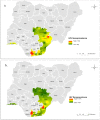Geographical Disparities in HIV Seroprevalence Among Men Who Have Sex with Men and People Who Inject Drugs in Nigeria: Exploratory Spatial Data Analysis
- PMID: 34028360
- PMCID: PMC8185612
- DOI: 10.2196/19587
Geographical Disparities in HIV Seroprevalence Among Men Who Have Sex with Men and People Who Inject Drugs in Nigeria: Exploratory Spatial Data Analysis
Abstract
Background: The assessment of geographical heterogeneity of HIV among men who have sex with men (MSM) and people who inject drugs (PWID) can usefully inform targeted HIV prevention and care strategies.
Objective: We aimed to measure HIV seroprevalence and identify hotspots of HIV infection among MSM and PWID in Nigeria.
Methods: We included all MSM and PWID accessing HIV testing services across 7 prioritized states (Lagos, Nasarawa, Akwa Ibom, Cross Rivers, Rivers, Benue, and the Federal Capital Territory) in 3 geographic regions (North Central, South South, and South West) between October 1, 2016, and September 30, 2017. We extracted data from national testing registers, georeferenced all HIV test results aggregated at the local government area level, and calculated HIV seroprevalence. We calculated and compared HIV seroprevalence from our study to the 2014 integrated biological and behavioural surveillance survey and used global spatial autocorrelation and hotspot analysis to highlight patterns of HIV infection and identify areas of significant clustering of HIV cases.
Results: MSM and PWID had HIV seroprevalence rates of 12.14% (3209/26,423) and 11.88% (1126/9474), respectively. Global spatial autocorrelation Moran I statistics revealed a clustered distribution of HIV infection among MSM and PWID with a <5% and <1% likelihood that this clustered pattern could be due to chance, respectively. Significant clusters of HIV infection (Getis-Ord-Gi* statistics) confined to the North Central and South South regions were identified among MSM and PWID. Compared to the 2014 integrated biological and behavioural surveillance survey, our results suggest an increased HIV seroprevalence among PWID and a substantial decrease among MSM.
Conclusions: This study identified geographical areas to prioritize for control of HIV infection among MSM and PWID, thus demonstrating that geographical information system technology is a useful tool to inform public health planning for interventions targeting epidemic control of HIV infection.
Keywords: Getis-Ord-Gi*; HIV seroprevalence; HIV testing modality; IBBSS; MSM; Nigeria; PWID; geospatial; hotspots; key population.
©Amobi Onovo, Abiye Kalaiwo, Moses Katbi, Otse Ogorry, Antoine Jaquet, Olivia Keiser. Originally published in JMIR Public Health and Surveillance (https://publichealth.jmir.org), 24.05.2021.
Conflict of interest statement
Conflicts of Interest: None declared.
Figures




Similar articles
-
Key Population Hotspots in Nigeria for Targeted HIV Program Planning: Mapping, Validation, and Reconciliation.JMIR Public Health Surveill. 2021 Feb 22;7(2):e25623. doi: 10.2196/25623. JMIR Public Health Surveill. 2021. PMID: 33616537 Free PMC article.
-
Sexual practices, sexual behavior and HIV risk profile of key populations in Nigeria.BMC Public Health. 2019 Sep 2;19(1):1210. doi: 10.1186/s12889-019-7553-z. BMC Public Health. 2019. PMID: 31477063 Free PMC article.
-
Key Population Size Estimation to Guide HIV Epidemic Responses in Nigeria: Bayesian Analysis of 3-Source Capture-Recapture Data.JMIR Public Health Surveill. 2022 Oct 26;8(10):e34555. doi: 10.2196/34555. JMIR Public Health Surveill. 2022. PMID: 36287587 Free PMC article.
-
HIV seroprevalence in five key populations in Europe: a systematic literature review, 2009 to 2019.Euro Surveill. 2021 Nov;26(47):2100044. doi: 10.2807/1560-7917.ES.2021.26.47.2100044. Euro Surveill. 2021. PMID: 34823636 Free PMC article.
-
Availability and Quality of Surveillance and Survey Data on HIV Prevalence Among Sex Workers, Men Who Have Sex With Men, People Who Inject Drugs, and Transgender Women in Low- and Middle-Income Countries: Review of Available Data (2001-2017).JMIR Public Health Surveill. 2020 Nov 17;6(4):e21688. doi: 10.2196/21688. JMIR Public Health Surveill. 2020. PMID: 33200996 Free PMC article. Review.
Cited by
-
Risk factors of HIV/AIDS among men who have sex with men in Akwa Ibom State, Nigeria.J Prev Med Hyg. 2024 Jan 1;64(4):E382-E397. doi: 10.15167/2421-4248/jpmh2023.64.4.2931. eCollection 2023 Dec. J Prev Med Hyg. 2024. PMID: 38379745 Free PMC article.
-
Diagnosis and case finding according to key partner risk populations of people living with HIV in Nigeria: A retrospective analysis of community-led index partner testing services.EClinicalMedicine. 2022 Jan 4;43:101265. doi: 10.1016/j.eclinm.2021.101265. eCollection 2022 Jan. EClinicalMedicine. 2022. PMID: 35028548 Free PMC article.
-
Factors associated with viral load testing and viral suppression among HIV-positive female sex workers in Nigeria.PLoS One. 2024 May 31;19(5):e0304487. doi: 10.1371/journal.pone.0304487. eCollection 2024. PLoS One. 2024. PMID: 38820395 Free PMC article.
References
-
- Tanser F, de Oliveira T, Maheu-Giroux M, Bärnighausen Till. Concentrated HIV subepidemics in generalized epidemic settings. Curr Opin HIV AIDS. 2014 Mar;9(2):115–25. doi: 10.1097/COH.0000000000000034. http://europepmc.org/abstract/MED/24356328 - DOI - PMC - PubMed
-
- Wand H, Ramjee G. Targeting the hotspots: investigating spatial and demographic variations in HIV infection in small communities in South Africa. J Int AIDS Soc. 2010 Oct 27;13:41. doi: 10.1186/1758-2652-13-41. https://jiasociety.biomedcentral.com/articles/10.1186/1758-2652-13-41 - DOI - DOI - PMC - PubMed
-
- Chimoyi LA, Musenge E. Spatial analysis of factors associated with HIV infection among young people in Uganda, 2011. BMC Public Health. 2014 Jun 05;14:555. doi: 10.1186/1471-2458-14-555. https://bmcpublichealth.biomedcentral.com/articles/10.1186/1471-2458-14-555 - DOI - DOI - PMC - PubMed
Publication types
MeSH terms
Substances
Grants and funding
LinkOut - more resources
Full Text Sources
Other Literature Sources
Medical

